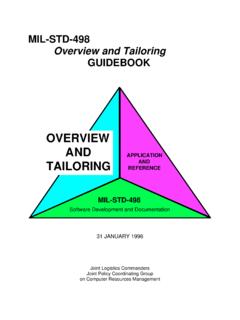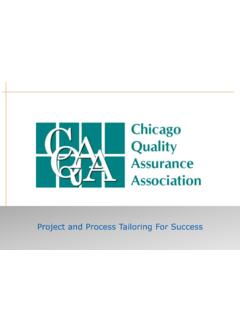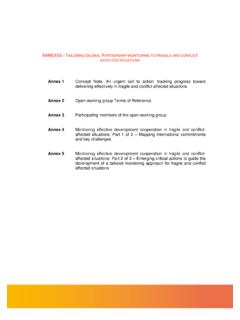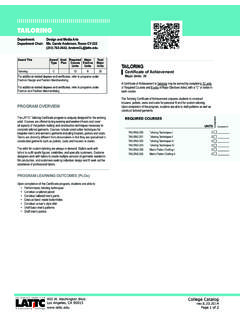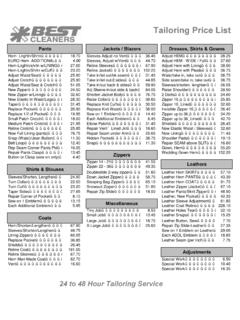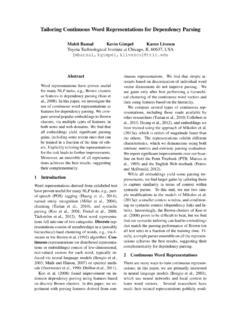Transcription of THE BENEFITS OF TAILORING - Crystal Consulting
1 WHITE PAPERTHE BENEFITS OF TAILORINGMAKING A PROJECT MANAGEMENT METHODOLOGY FITBy Sean Whitaker, BA, MSc, MBA, PMP2 The Bene ts of TAILORING : Making a Project Management Methodology Fit 2014 Project Management Institute, of ContentsIntroduction ..3 Project Management Methodologies and TAILORING ..4 How to Tailor a Project Management Methodology ..6 Initial TAILORING ..7 Pre-project TAILORING ..11 Intra-project TAILORING ..11 Observations From the Field ..12 Summary ..18 References ..19 Appendix 1 - Project Management Methodology Checklist.
2 20 Appendix 2 - Methodology Process Flow Chart ..21 Appendix 3 - Data Collection ..223 September 2014 2014 Project Management Institute, Implementing Organizational Project Management: A Practice Guide (PMI, 2014), practitioners have a broad and general introduction to ways an organization can integrate its portfolio, program and project management practices into its overall organizational management. A key part of this publication, chapter 5, How to Develop a Tailored Organizational Project Management Methodology, presents a process to enable practitioners and organizations to develop their own tailored organizations have unsuccessfully tried to implement an off-the-shelf, or ready-made, project management methodology and found that it was unsuitable for their particular projects, their organization, and their level of organizational project management maturity.
3 This often results in a lot of money, time and effort spent with little return. While the original intent was an increase in successful projects, the actual outcome was the opposite often accompanied with a decrease in staff committing to any initiative to introduce a project management methodology, it is important to answer the question, Why have a methodology at all? Furthermore, if an organization chooses to have a defined methodology, why a tailored methodology and not an off-the-shelf methodology? Answering these questions will reveal the link to more successful projects.
4 And delivering projects more successfully is the goal of any professional project management PMI (2013a) Pulse of the Profession report found that organizations with developed project management practices, BENEFITS realization processes, portfolio management practices and program management practices and those with high organizational agility all have significantly better project outcomes than their counterparts who are less advanced in their project management practices ( ). This paper spotlights project management methodologies tailored for organizational fit and examines how they are a key component of those effective project management paper proposes a model and process for the initial and ongoing TAILORING of a project management methodology.
5 The goal is to enable organizations and project management practitioners to develop and tailor their own project management methodologies to improve efficiency, effectiveness and the likelihood of project secondary goal of this paper is to explore the links between project management methodologies and project success. We conducted research that invited project management practitioners from a range of industries to provide accounts of their experience with project management methodologies, project success and organizational project management maturity.
6 The second part of this paper presents the findings of this research and reveals a link between a tailored project management methodology and the successful delivery of a Bene ts of TAILORING : Making a Project Management Methodology Fit 2014 Project Management Institute, Management Methodologies and TailoringA Guide to the Project Management Body of Knowledge (PMBOK Guide) (PMI, 2013b) defines a methodology as a system of practices, techniques, procedures and rules (p. 546). More specifically, a project management methodology is a defined, documented and discoverable set of policies, practices, processes, tools, techniques and templates that provide guidance on how projects are run within an organization.
7 A methodology can be extensive or minimal; rigorous or lightweight; complex or simple; linear or highly iterative; described in phases or described for the entire project lifecycle. There is no one, single project management methodology that should be applied to all projects all of the time. A project management methodology should reflect the size, duration and complexity of each individual project, and be adapted to the industry, organizational culture and level of organizational project management maturity of the organization. A methodology is typically derived from a project management framework document or standard such as the PMBOK is the process of referencing framework documents, standards and other relevant sources and utilizing those elements that provide processes, tools and techniques that are suitable for that particular organization.
8 It also includes modifying existing processes currently in use by the organization. As such, the process of TAILORING is a process of customizing a project management methodology. The result of TAILORING is that the project management methodology will be suitable for use in specific types of projects, and a tailored methodology will reflect the size, complexity and duration of the project as appropriate for the organizational context along with adaptation to the industry within which the project is undertaken. General examples of TAILORING include the trend for IT projects to use agile-based approaches, while construction projects more often use a waterfall approach.
9 Organizational culture is another dimension influencing TAILORING . An organization with a low tolerance for risk may have many processes and procedures to guide project management throughout its lifecycle; while a similar company operating in the same market but with a high tolerance for risk may have fewer processes and procedures. For example, in American Productivity & Quality Center s Effective Project Management Offices study (APQC, 2013), Dell Services, a business unit of Dell, Inc., reported using a four-level ranking system to categorize project complexity.
10 At the highest level, projects use a high degree of rigor. As the level of complexity decreases, so too does the level of rigor and level of monitoring. Project performance is monitored using an established framework for consistent reporting across all PMBOK Guide (PMI, 2013b) points out that the process of TAILORING is the responsibility of the project manager when it says:..[F]or any given project, the project manager, in collaboration with the project team, is always responsible for determining which processes are appropriate, and the appropriate degree of rigor for each process.
